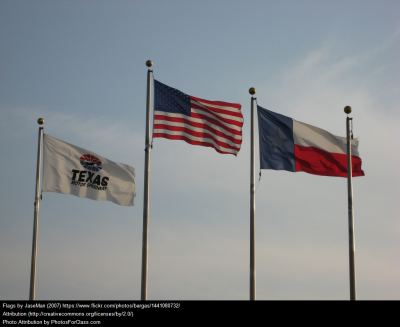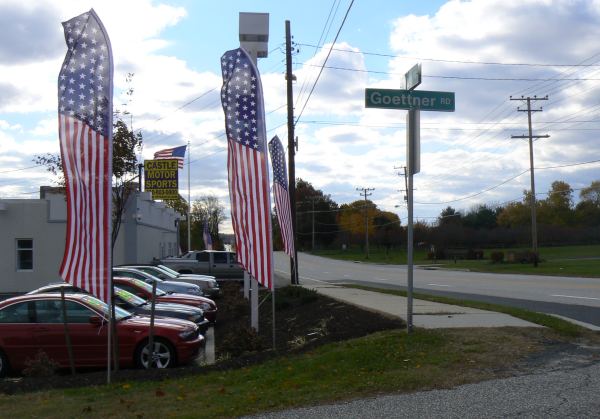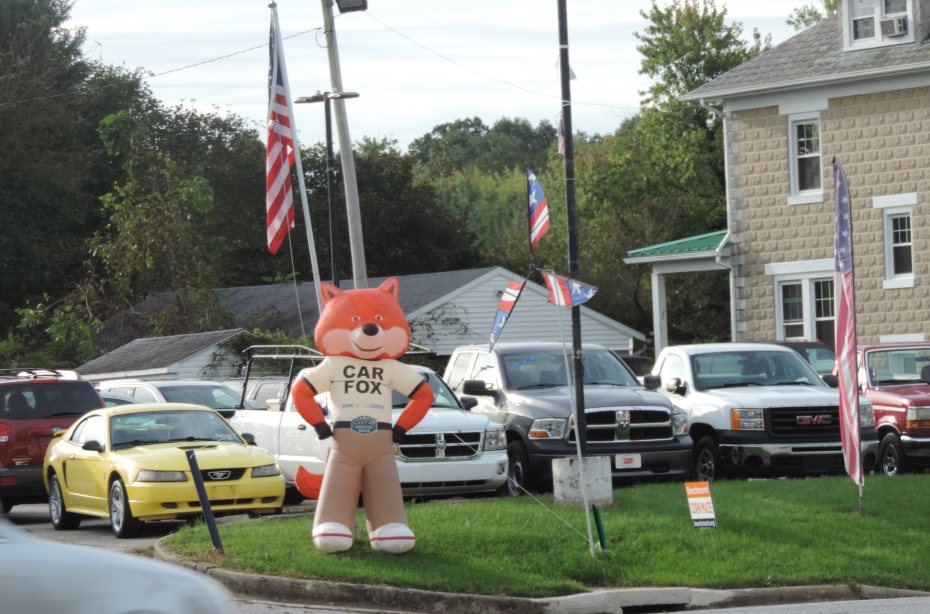Flags, feather flags, pennants, streamers, and the like
|
The Sign Code, §450 of the Baltimore County Zoning Regulations (BCZR), prohibits flags, pennants, ribbons, and streamers except for flags exempted as follows:
Further, it defines "flag" as "A panel of fabric of distinctive design that is used as a symbol (as of a nation), as a signaling device, or as a decoration." This definition was reaffirmed as recently as 2008 in Bill 106-2008 when this current definition was adopted. Also, US Federal law prohibits the use of the US flag, or any representation of it (stars and strips with red, white, and blue), for commercial purposes or for advertising. It is unclear how this Federal law actually applies to their use locally, but it is a clear statement of intent. While one might successfully argue that what they are doing is not technically a punishable violation, doing these sort of things is an obvious case of disrespect for the flag, especially for someone who claims to be such a patriot and good citizen. How about this local display in Kingsville with a string of shredded US flags? Disgusting, isn't it!
Any complaint filed against these "pennants" would most likely be dismissed with the argument that they are "flags", and therefore exempt. Actually, it is not an "argument" since citizens never get the chance to disagree or discuss the dismissal of a complaint that they file. In fact, there is seldom even a reason given - just leave the citizen in the dark and wondering why nothing was done!
Unfortunately, this exemption has been abused by many businesses that are both using the US flag as a commercial promotion tool, and are putting up other things that they call "flags", which are really pennants or vertical banners.
At the hearing, when the inspector presented the hearing officer with his evidence, including photos, the hearing officer immediately stated "I don't see any violation here", to which the business's lawyer immediately made a motion to dismiss based on the hearing officer's statement, which was immediately granted, without any opportunity for us to object. (The County Code states that the hearing officer makes a determination after testimony is given.) To those of us present, it was quite obvious that this interaction between the hearing officer and the defendant's attorney had been pre-arranged - which would be a serious violation. This business closed several years ago, but the action in a CE hearing kind of set the mood for later actions. At least in recent cases, CE has seemed to be applying the one sign limit, although the BCZR does not really set a limit on the number of US flags that can be displayed (thus what is shown in the photo above is hard to fight.) Besides, by exempting a "flag of a nation", without specifying which nation, that leaves the business a couple hundred designs to choose from.
Legislative Action NeededSince many of these "temporary" flags are dangerous since they can blow away in the wind, and it is only a matter to time before someone is injured, legislative action is needed to tighten-up the exemption. The fix is to remove the exemption for "flags" and to add specific text for what is allowed, which should be a maximum of one each US flag, foreign country, state flag, and company emblem or logo, each flying from a permanently installed flag pole, where each country or state flag is exactly as defined by that jurisdiction. And this limit should clearly apply per parcel or group of parcels under joint ownership. |

 Any reasonable person reading the County Code would understand that this exemption refers to the practice, such as at large companies, of flying a US flag, a state flag, and one showing their trademarked emblem on one or three tall flagpoles by their office building, as pictured on the left. Thus, the otherwise applicable height limits would not apply to a "flag pole" and the flag on it.
Any reasonable person reading the County Code would understand that this exemption refers to the practice, such as at large companies, of flying a US flag, a state flag, and one showing their trademarked emblem on one or three tall flagpoles by their office building, as pictured on the left. Thus, the otherwise applicable height limits would not apply to a "flag pole" and the flag on it. In Kingsville, we first ran into the County's refusal to prosecute this matter back in 2007. When we seemed to have an inspector who cared, we had been successful in getting CE to issue a citation against a local business for putting up a bunch of these vertical banners, sometimes called "feather flags" (pictured on the right). Several of us were ready to testify at the hearing that, not only were these a violation of County Code and US law, but they were a danger in that they blocked the view of drivers exiting Goettner Rd (on to high-speed Belair Rd). Also, the inspector was expected to testify that he had just attended, at County expense, a training class at which it was explained that these were not really US flags, so not protected in any way. I was ready with documentation as to what constitutes a legal US flag.
In Kingsville, we first ran into the County's refusal to prosecute this matter back in 2007. When we seemed to have an inspector who cared, we had been successful in getting CE to issue a citation against a local business for putting up a bunch of these vertical banners, sometimes called "feather flags" (pictured on the right). Several of us were ready to testify at the hearing that, not only were these a violation of County Code and US law, but they were a danger in that they blocked the view of drivers exiting Goettner Rd (on to high-speed Belair Rd). Also, the inspector was expected to testify that he had just attended, at County expense, a training class at which it was explained that these were not really US flags, so not protected in any way. I was ready with documentation as to what constitutes a legal US flag.

